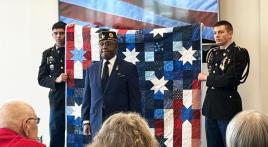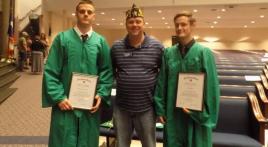I'm 90 years old, and served in the U.S. Army during World War II.
My father was a large operator in the sawmilling and timber industry across northern Virginia. I graduated from high school in Fairfax, Va., in 1941, and worked with him handling heavy oak lumber the following year. This work made me bull-strong and solid as a rock.
Then came my papers from Uncle Sam: "I want you!" I was drafted and sent to Camp (now Ft.) Hood, Texas. There, I joined the 113th Cavalry. We trained in recon, strategy and tactics. I was selected for a special six-week schooling in explosives of all types, including mine laying and removal. The original regiment was established as a horse cavalry, then was equipped as armored cavalry - with light tanks, armored cars, jeeps, etc. - built for moving quickly.
While I was on my furlough from training, my high school sweetheart and I were engaged and married in 1943.
Following 10 months at Hood, the regiment moved to Louisiana to learn war maneuvers for two months. Next we were sent to Boston by train. There, we were loaded onto an old tub converted into a troop ship for a 10-day trip across the Atlantic. Most of the voyage was up and down, riding 30-foot high waves, making everyone sick. In January 1944, we landed in Glasgow, Scotland.
We rode a British train to Camp Lobscomb, approximately 10 miles north of Salisbury, for more training. Our commander, Col. William Biddle, determined that two squadrons could do better fighting and recon work than one regiment. Thus, he split the regiment into two squadrons, the 113th Armored Cavalry Recon Squadron and the 125th Armored Cavalry Recon Squadron.
We loaded onto LSTs and landed on June 16, 1944 on Omaha Beach in Normandy, France. The first assignment was to take two towns, La Graverie and St. Jean-de-Daye. This was a three-day operation. On the next mission, our 125th Squadron attached to the 116th Infantry Regiment of the 29th Division to take the town of St. Lo. This was accomplished.
There is a story to tell here. A much-admired major in the 116th commanded his the officers to inform the troops they would take St. Lo that day. He was killed on the way to the town, but the troops completed the mission for him. His 116th troopers so much liked the major that they wanted his body brought to St. Lo. He was placed on a stretcher, put on a 125th Cavalry jeep and with a 125th armored car, reached the town. I have seen one picture of the major's body placed on the rubble, with the jeep and car parked alongside.
Following this, at Col. Biddle's request, other units were attached to our two squadrons, and we were then attached to the 19th Corps. We rapidly moved through northern France, Belgium and Holland to the Siegfried Line. In mid-April 1945, the 113th and 125th crossed the Elbe River. After some ferocious fighting, we met the lead elements of the Russian Army near Wittenberg, Germany that month. The rest of the war was clearing small pockets of German resistance here and there.
Once the war ended, we were shipped back to the States.



